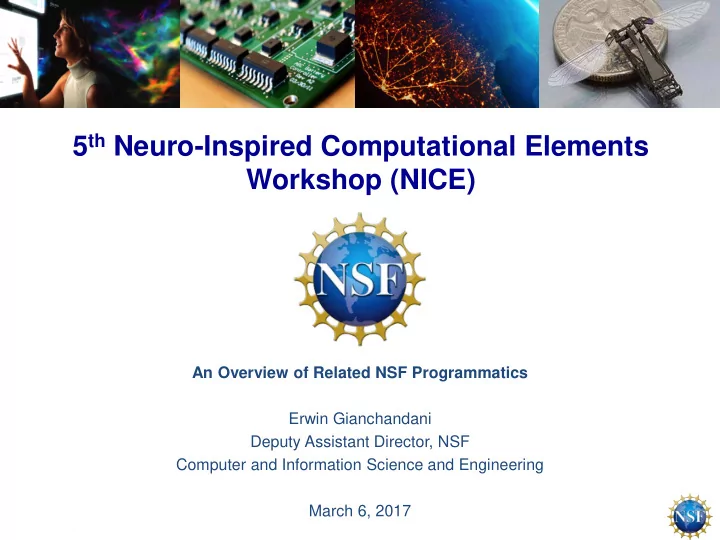

5 th Neuro-Inspired Computational Elements Workshop (NICE) An Overview of Related NSF Programmatics Erwin Gianchandani Deputy Assistant Director, NSF Computer and Information Science and Engineering March 6, 2017 Image Credit: Exploratorium.
Future Computing “The end of dramatic exponential growth in single-processor performance marks the end of the dominance of the single microprocessor in computing. The era of sequential computing must give way to a new era in which parallelism is at the forefront.” “Today, we stand at a point where exponential advances in the science and technology of computing and concomitant advances in approaches to brain sciences have ignited new opportunities to forge connections between these two fields.”
F E DE RALVISION F OR A GRAND CHAL L E NGE White pa pe r re le a se d b y DOE , NSF , DOD, NI ST , I C July 29, 2016
CISE programs address national priorities Image Credit: ThinkStock Image Credit: CCC and SIGACT CATCS Image Credit: Eliza Grinnell/Harvard SEAS Image Credit: ThinkStock National Robotics Understanding the Big Data Cybersecurity Initiative Brain Image Credit: Texas Advanced Computing Center Image Credit: WINLAB, Rutgers University Image Credit: US Ignite Image Credit: Calvin Lin, University of Texas, Austin Smart Cities Computer Science Advanced Wireless National Strategic for All Research Computing Initiative For a comprehensive list of CISE funding opportunities, visit: http://www.nsf.gov/funding/pgm_list.jsp?org=CISE
Understanding the Brain (UtB) • Enables scientific understanding of the full complexity of the brain, in action and in context, through targeted, cross-disciplinary investments • CISE programs: - Collaborative Research in Computational Neuroscience (CRCNS) in collaboration with NIH, Germany, France, and Israel - Integrative Strategies for Understanding Neural and Cognitive Systems (NSF-NCS) with EHR, ENG, and SBE - CISE/IIS Robust Intelligence core program - Science & Technology Center for Brains, Minds, and Machines
National Strategic Computing Initiative (NSCI) • NSF investments in NSCI aim to: - Increase coherence between technology used for modeling and simulation and that used for data analytics - Establish a path forward for future HPC Image Credit: Angus Silver and Padraig Gleeson, systems after reaching the current limits University College London Image Credit: NSF of semiconductor technology (in the “post Moore’s Law era”) - Advance scientific discovery through the broader High-Performance Computing (HPC) ecosystem • NSF co-leading with DOD and DOE Image Credit: NCSA/University of Illinois
Scalable Parallelism in the Extreme (SPX) Increasing computing performance in the modern era of parallel computing • Aligns with NSCI • Aims to establish collaborations among researchers representing all areas from the application layer down to the micro- Science APIs, Science APIs, Science APIs, Science APIs, portals, portals, portals, portals, architecture gateways gateways gateways gateways Data Services - Proposals required to have two or more PIs providing different, distinct expertise Existing CI services private, campus, • Research areas: international commercial NSF-supported national CI ecosystem cloud resources … … … - Algorithms … … National/International Research and Education Network - Programming Languages and Systems - Applications - Architecture and Systems - Extensible Distributed Systems - Performance Predictability • $60M invested in FY 2013-FY 2016 under XPS; new competition in FY 2017
Energy-Efficient Computing: From Devices to Architectures (E2CDA) • Challenge: Future performance improvements across the board are now severely limited by the amount of energy it takes to manipulate, store, and critically, transport data • Aligns with NSCI and nanotechnology-inspired Grand Challenge for Future Computing: – Disruptive system architectures, circuit microarchitectures, and attendant device and interconnect technology aimed at achieving the highest level of computational energy efficiency – Revolutionary device concepts and associated circuits and architectures that will greatly extend the practical engineering limits of energy-efficient computation • Funded $18M in new awards in FY 2016; new competition in FY 2017
NSF/Intel Partnership on Computer Assisted Programming for Heterogeneous Architectures (CAPA) • Aims to significantly improve software development productivity by partially or fully automating software development tasks • Proposals should address Programmer Effectiveness, Performance Portability, and Performance Predictability within the research areas: – Programming abstractions and methodologies – Program synthesis and learning – Hardware-based abstractions – Software engineering tools and practices • Intel agreements contain provisions for possible direct, on-site participation in research by Intel researchers-in-residence
Future Computing • Tremendous national need and opportunity • Long-term focus and approach • Cross-agency and cross-section collaborations essential
Recommend
More recommend